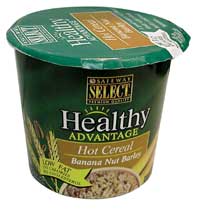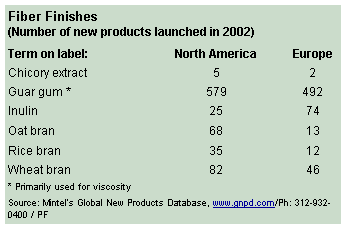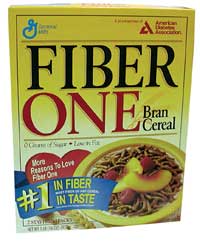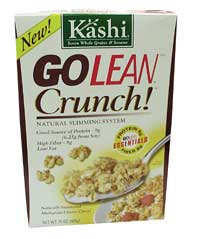
Dieting with Dietary Fiber
The fiber intake of Americans stubbornly remains below recommended amounts, while the calorie intake remains high. Neither leads to optimal health. Indeed, “globesity” is a worldwide problem. The London-based International Obesity Task Force recently stated that some 1.7 billion are overweight or obese worldwide. This is 50% more than an earlier estimate that did not take into account that Asians appear more vulnerable to the negative health effects of excess weight. People with a Body Mass Index (BMI) of 25 or more had been considered overweight; those with a BMI of 30 or more were obese. An expert group at the World Health Organization now says Asians with a BMI of only 23.3 may be at increased risk of obesity-related diseases.The American Council on Science and Health (New York) says it is uncertain whether dietary fiber has specific benefits in weight control. However, it is generally felt that people with diets rich in fiber diets are less likely to be obese. Some of the mechanisms through which dietary fiber may impact weight include reduced energy intake, flattening blood glucose response after carbohydrate ingestion and increased satiety, among many others. (See the Quaker Oats' website below.)
A number of companies both enhance the dietary fiber and reduce the fat content in their products. For example, Brownberry Bakery Light, 100% Whole Wheat Bread introduced in 2002 by Arnold Foods (Totowa, N.J.), parent company George Weston Bakeries Inc., notes it has 40 calories per slice (1/3 fewer calories than regular wheat bread). It also notes that it is “an excellent source of fiber,” which is derived from its whole wheat flour, soy fiber and wheat bran.
In another example, Safeway Select Safeway Inc.'s (Pleasanton, Calif.) Healthy Advantage cup cereals deliver significant fiber doses in a lowfat format. Toasted whole oats, triticale flakes, rolled whole barley and raisins provide 21% of the daily value for fiber in a 1.8-oz. container of a Maple Raisin Three Grain variety. A banana-pecan-barley (rolled whole and cracked) version serves up 22% of the daily value. Both products note that all ingredients are vegetarian.

Defining Moments
The definition of dietary fiber continues to be a source of debate. Currently, the U.S. and Canada have slightly different definitions. The American Association of Cereal Chemists (St. Paul, Minn.) issued a revised definition of dietary fiber a few years ago to include physiological aspects, as opposed to a definition based on analytical chemistry, upon which the current definition is based.
Last year, the Food and Nutrition Board, part of the National Academy of Sciences (Washington), issued a revised definition of dietary fiber as consisting of edible, non-digestible carbohydrates and lignin naturally found in plant food. One of its goals was to develop an internationally accepted definition. Functional fiber consists of non-digestible carbohydrates that are isolated or extracted from natural or synthetic sources and has a beneficial physiological effect in humans. Total dietary fiber is the sum of dietary fiber and functional fiber.

Other claims for inulin and related fructans include improved bowel habit, reduction of the risks of osteoporosis (i.e., improved calcium bioavailability), cardiovascular disease, obesity and, possibly, Type 2 diabetes.
Mintel International's GNPD (Chicago) lists 82 records of foods and beverages introduced into the U.S. and Canada since January 2000. Examples introduced this year include Cheetah Chomps Natural Strawberry Flavor Organic Cereal from Nature Path (Delta, B.C.) that was added to its EnviroKidz lineup, Spinach Veggie Nuggets under the Veggie Patch brand from FoodTech (New Haven, Conn.) and Lunchables Fun Fuel Wraps from Oscar Mayer Foods (Madison, Wisc.), owned by Altria Group.
However, dairy products already containing probiotic cultures are one of the biggest applications of inulin and oligofructans. For example, General Mills' Yoplait USA (Reed City, Mich.) introduced Nouriche, a nonfat yogurt smoothie, last year. With 6g fiber and a number of fortifiers, it is said to provide the nourishment of a meal—and, at 290 calories, nearly the calories as well. [Editors' note: And, in this case, well worth it!]

Coming and Going
Interest in fiber again is validated by a study in Japan, which studied how different types of dietary fiber affected the lipid metabolism and immune function of eight-month-old Sprague-Dawley rats. The scientists fed the animals different fibers, such as cellulose, guar gum, partially hydrolyzed guar gum, glucomannan and highly methoxylated pectin. Guar gum significantly decreased appetite and weight gain, and increased liver weight and IgM productivity in MLN lymphocytes. This suggests that that enhancement of immune systems was seen in the gut immune system. The study was published this spring in the Japanese journal Bioscience, Biotechnology and Biochemistry (2003, 67:429-433).
Those impatient to get a good start on their daily fiber intake can ingest 57% of the Recommended Daily Allowance (RDA) in one serving of General Mills' (Minneapolis) Fiber One Bran Cereal. Already familiar to Americans, the cereal recently was introduced in Singapore, where its wheat bran, corn bran and guar gum will help Asian citizens fight heart disease, colon cancer, constipation and diarrhea, contributing to their general well-being. With such high fiber content, this cereal may not be for the meek!

To this end, Kellogg USA's Kashi Company's (La Jolla, Calif.) Kashi GoLean Crunch Multigrain Cluster Cereal offers fiber in the form of Kashi seven whole grains and sesame cereal. The latter encompasses whole: oats, long grain brown rice, rye, hard red Winter wheat, triticale, buckwheat, barley and sesame seeds. Barley often is featured in whole grain breads while the hard red Winter wheat also is found in Kashi nutrition bars and waffles. As if that were not enough, the product also contains chicory root fiber and whole grain oats. The diverse sources of fiber contribute to an interesting texture and wholesome taste.
Website Resources
www.quakeroatmeal.com/HealthPros/LIB/OR_satiety_print.html— Quaker Oats' site on dietary fibers' impact on weight controlhttp://news.bbc.co.uk/1/hi/health/2253004.stm— World's obesity problem
http://news.bbc.co.uk/1/hi/health/2856605.stm— More information on obesity epidemic
www.bbc.co.uk/health/yourweight/bmi.shtml— Calculating your BMI
www.md-phc.com/fiber/indexfib.html— Unicity commercial site with much information on dietary fiber
www.aaccnet.org/DietaryFiber/top.htm— AACC sites on dietary fiber definition
www.aaccnet.org/grainbin/definitiondietaryfiber.asp— More on definition
wwwsoc.nii.ac.jp/jsbba/bbb6702e.html#36— Abstract on immune-enhancement with fiber in rodents
www.agctr.lsu.edu/subjects/eatsmart/fiber2.htm— A good review of the food guide pyramid with respect to dietary fiber
www.jhbmc.jhu.edu/cardiology/rehab/fiber.html— Basic fiber facts and info presented by the Johns Hopkins Bayview Medical Center
http://rex.nci.nih.gov/NCI_Pub_Interface/raterisk/risks73.html— Information about diet and cancer risk, from the National Institute of Health
www.naturespath.com
www.veggiepatch.com
Some of the information in this article was derived from Mintel International's Global New Products Database, www.gnpd.com, 312-932-0400. For more information on the GNPD, email kthackston@mintel.com

Sidebar: Going Global
From commodity foods to sophisticated formulated products, companies the world over tout their product's fiber content.
Takara Shuzo (Shimogyo-ku Kyoto, Japan) introduced, in September 2002, a Konjac Aloe Diet beverage under the Self Care brand. The GNPD notes that it is a diet drink with Gymnema sylvestre extract and vitamins C, B6 and B12. Sweetness could be provided by sucralose, “isomerized liquid sugar,” and hydrogenated maltose (i.e., D-maltitol), as well as the fruits (lemons and grapes) that are 10% of the product. The G. sylvestre extract, however, normally decreases the ability to sense sweetness and, in alternative medicine, is used as an aid for diabetes. The 7.7g per 180ml of fiber are from sources such as konjac powder with glucommanna (also noted to improve intestinal health), aloe vera pulp, cyclic and other oligosaccharides and unspecified dietary fibers. The price for the 900ml bottle? Euro 3.19, US $2.98 or Yen 398.00.

Under the strategy of making the most of what Mother Nature gives you, S&P Food, (Selangor Darul Ehsan, Malaysia), introduced a lowfat product that is high in natural fibers with no preservatives, artificial flavorings or colorings. What is this politically correct item that meets so many of today's trends?…Grated coconut.
